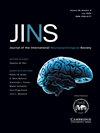1 胎儿酒精谱系障碍儿童和青少年的认知节奏缓慢:与执行功能和皮层下体积的关系
IF 2.6
4区 心理学
Q2 CLINICAL NEUROLOGY
Journal of the International Neuropsychological Society
Pub Date : 2023-12-22
DOI:10.1017/s1355617723007762
引用次数: 0
摘要
目的:胎儿酒精谱系障碍(FASD)是一种常见的神经发育疾病,与认知功能(执行功能、注意力、工作记忆等)缺陷、行为障碍以及包括皮质和皮质下体积在内的大脑结构异常有关。在患有 FASD 的儿童中,合并注意力缺陷/多动症(ADHD)的比例很高,这也是造成严重功能障碍的原因之一。认知节奏迟缓(SCT)包括一组症状(如活动不足/行动迟缓、困惑、迷糊、做白日梦),这些症状与注意力缺陷多动症(ADHD)有关,但又有所不同。我们通过研究SCT与大脑体积(胼胝体、尾状体和海马体)和客观EF测量之间的关系,对FASD儿童与发育正常对照组儿童的SCT进行了探讨。参与者和方法:这是对CIFASD大型纵向研究的二次分析,该研究由35名产前酒精暴露(PAE)儿童和30名9至18岁对照组儿童组成。儿童完成了一系列认知评估(WISC-IV、DKEFS、& NIH Toolbox)和核磁共振成像扫描,而家长则完成了儿童行为检查表(CBCL),其中包括一个 SCT 量表。我们研究了 PAE 和对照组在 SCT 症状、EF 分数和皮层下体积方面的群体差异。然后,我们在控制或不控制颅内总容积、年龄、注意力问题和多动症问题的情况下,对 SCT 和皮层下脑容量进行组内和组间比较。结果:与对照组相比,PAE 患者在 CBCL 中表现出更多的 SCT 症状(t [57] = 3.66,p = 0.结果发现:与对照组相比,PAE 患者在 CBCL 中的 SCT 症状明显增多(t [57] = 3.66,p = 0.0006),家长评定的注意力问题和 ADHD 症状增多,多项 EF 测量得分较低(DKEFS 创迹和言语流畅性;WISC-IV 数字跨度、符号搜索和编码;效应大小从 0.44 到 1.16 不等),尾状核、海马和胼胝体后部区域体积较小。在 PAE 组中,较小的海马体与较多的 SCT 症状相关(控制了家长评定的注意力问题和多动症问题、年龄和颅内容积)。然而,在对照组中,较大的中后部和后部胼胝体与较多的 SCT 症状显著相关(控制了家长评定的注意力问题、颅内容积和年龄;r [24] = 0.499,p = 0.009;r [24] = 0.517,p = 0.007)。在执行功能方面,PAE 组中有较多 SCT 症状的儿童在 Trail-Making 分测验(控制注意力问题&;ADHD 症状)的字母排序方面表现较差。结论:研究结果表明,与发育正常的对照组相比,FASD患儿的SCT症状较重,这可能与他们在EF任务中的表现较差以及皮层下体积(海马体)较小(考虑到注意力障碍和ADHD症状)有关。对 FASD 儿童 SCT 的根本原因和相关因素进行更深入的研究,可改进针对这一人群的干预措施。本文章由计算机程序翻译,如有差异,请以英文原文为准。
1 Sluggish Cognitive Tempo in Children and Adolescents with Fetal Alcohol Spectrum Disorders: Associations with Executive Function and Subcortical Volumes
Objective:Fetal alcohol spectrum disorder (FASD) is a common neurodevelopmental condition associated with deficits in cognitive functioning (executive functioning [EF], attention, working memory, etc.), behavioral impairments, and abnormalities in brain structure including cortical and subcortical volumes. Rates of comorbid attention-deficit/hyperactivity disorder (ADHD) are high in children with FASD and contribute to significant functional impairments. Sluggish cognitive tempo (SCT) includes a cluster of symptoms (e.g. underactive/slow-moving, confusion, fogginess, daydreaming) found to be related to but distinct from ADHD, and previous research suggests that it may be common in FASD. We explored SCT by examining the relationship between SCT and both brain volumes (corpus callosum, caudate, and hippocampus) and objective EF measures in children with FASD vs. typically developing controls.Participants and Methods:This is a secondary analysis of a larger longitudinal CIFASD study that consisted of 35 children with prenatal alcohol exposure (PAE) and 30 controls between the ages of 9 to 18 at follow-up. Children completed a set of cognitive assessments (WISC-IV, DKEFS, & NIH Toolbox) and an MRI scan, while parents completed the Child Behavior Checklist (CBCL), which includes a SCT scale. We examined group differences between PAE and controls in relation to SCT symptoms, EF scores, and subcortical volumes. Then, we performed within-and between-group comparisons with and without controlling for total intracranial volume, age, attention problems, and ADHD problems between SCT and subcortical brain volumes. Finally, we performed correlations between SCT and EF measures for both groups.Results:Compared to controls, participants with PAE showed significantly more SCT symptoms on the CBCL (t [57] = 3.66, p = 0.0006), more parent-rated attention problems and ADHD symptoms, lower scores across several EF measures (DKEFS Trail-Making and Verbal Fluency; WISC-IV Digit Span, Symbol Search, and Coding; effect sizes ranging from 0.44 to 1.16), and smaller regional volumes in the caudate, hippocampus, and posterior areas of the corpus callosum. In the PAE group, a smaller hippocampus was associated with more SCT symptoms (controlling for parent-rated attention problems and ADHD problems, age, and intracranial volume). However, in the control group, a larger mid posterior and posterior corpus callosum were significantly associated with more SCT symptoms (controlling for parent-rated attention problems, intracranial volume, and age; r [24] = 0.499, p = 0.009; r [24] = 0.517, p = 0.007). In terms of executive functioning, children in the PAE group with more SCT symptoms performed worse on letter sequencing of the Trail-Making subtest (controlling attention problems & ADHD symptoms). In comparison, those in the control group with more SCT symptoms performed better on letter sequencing and combined number letter sequencing of the Trail-Making subtest (controlling attention problems).Conclusions:Findings suggest that children with FASD experience elevated SCT symptoms compared to typically developing controls, which may be associated with worse performance on EF tasks and smaller subcortical volumes (hippocampus) when taking attention difficulties and ADHD symptoms into account. Additional research into the underlying causes and correlates of SCT in FASD could result in improved tailoring of interventions for this population.
求助全文
通过发布文献求助,成功后即可免费获取论文全文。
去求助
来源期刊
CiteScore
5.40
自引率
3.80%
发文量
185
审稿时长
4-8 weeks
期刊介绍:
The Journal of the International Neuropsychological Society is the official journal of the International Neuropsychological Society, an organization of over 4,500 international members from a variety of disciplines. The Journal of the International Neuropsychological Society welcomes original, creative, high quality research papers covering all areas of neuropsychology. The focus of articles may be primarily experimental, applied, or clinical. Contributions will broadly reflect the interest of all areas of neuropsychology, including but not limited to: development of cognitive processes, brain-behavior relationships, adult and pediatric neuropsychology, neurobehavioral syndromes (such as aphasia or apraxia), and the interfaces of neuropsychology with related areas such as behavioral neurology, neuropsychiatry, genetics, and cognitive neuroscience. Papers that utilize behavioral, neuroimaging, and electrophysiological measures are appropriate.
To assure maximum flexibility and to promote diverse mechanisms of scholarly communication, the following formats are available in addition to a Regular Research Article: Brief Communication is a shorter research article; Rapid Communication is intended for "fast breaking" new work that does not yet justify a full length article and is placed on a fast review track; Case Report is a theoretically important and unique case study; Critical Review and Short Review are thoughtful considerations of topics of importance to neuropsychology and include meta-analyses; Dialogue provides a forum for publishing two distinct positions on controversial issues in a point-counterpoint format; Special Issue and Special Section consist of several articles linked thematically; Letter to the Editor responds to recent articles published in the Journal of the International Neuropsychological Society; and Book Review, which is considered but is no longer solicited.

 求助内容:
求助内容: 应助结果提醒方式:
应助结果提醒方式:


